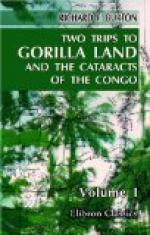The rainy seasons are healthier for the natives than the cold seasons; and the explorer is often urged to take advantage of them. He must, however, consult local experience. Whilst ascending rivers in November, for instance, he may find the many feet of flood a boon or a bane, and his marching journeys are nearly sure to end in ulcerated feet, as was the case with poor Dr. Livingstone. The rains drench the country till the latter end of December, when the Nanga or “little dries” set in for two months. The latter also are not unbroken by storms and showers, and they end with tornadoes, which this year (1862) have been unusually frequent and violent. Thus we may distribute the twelve months into six of rains, vernal and autumnal, and six of dry weather, aestival and hibernal: the following table will show the sub-sections:—
Early December to early February, the “little dries;” February to early April, the “former,” early or spring rains; May to early June, the variable weather; June to early September, the Cacimbo, Enomo, long or middle dries; September to early December, the “latter rains.”
Under such media the disease, par excellence, of the Gaboon is the paroxysm which is variously called Coast, African, Guinea, and Bullom fever. Dr. Ford, who has written a useful treatise upon the subject,[FN#7] finds hebdomadal periodicity in the attacks, and lays great stress upon this point of chronothermalism. He recognizes the normal stages, preparatory, invasional, reactionary, and resolutionary. Like Drs. Livingstone and Hutchinson, he holds fever and quinine “incompatibles,” and he highly approves of the prophylactic adhibition of chinchona used by the unfortunate Douville in 1828. Experience in his own person and in numerous patients “proves all theoretical objections to the use of six grains an hour, or fifty and sixty grains of quinine in one day or remission to be absolutely imaginary.” He is “convinced that it is not a stimulant,” and with many apologies he cautiously sanctions alcohol, which should often be the physician’s mainstay. As he advocated ten-grain doses of calomel by way of preliminary cathartic, the American missionaries stationed on the River have adopted a treatment still more “severe”—quinine till deafness ensues, and half a handful of mercury, often continued till a passage opens through the palate, placing mouth and nose in directer communication. Dr. Ford also recommends during the invasion or period of chills external friction of mustard or of fresh red pepper either in tincture or in powder, a good alleviator always procurable; and the internal use of pepper-tea, to bring on the stages of reaction and resolution. Few will agree with him that gruels and farinaceous articles are advisable during intermissions, when the patient craves for port, essence of beef, and consomme; nor can we readily admit the dictum that in the tropics “the most wholesome diet, without doubt, is chiefly vegetable.” Despite Jacquemont and all the rice-eaters, I cry beef and beer for ever and everywhere! Many can testify personally to the value of the unofficinal prescription which he offers in cases of severe lichen (prickly heat), leading to impetigo. It is as follows, and it is valuable:—




